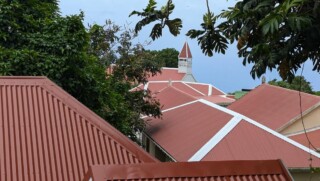Study into slow recovery sea-urchin population Dutch Caribbean

KRALENDIJK- A collaborative study between Van Hall Larenstein, Wageningen University and Research (WUR), STENAPA, Caribbean Netherlands Science Institute (CNSI) and NIOZ Royal Netherlands Institute for Sea Research worked to unravel the mystery behind the slow recovery rate of these vital species.
As both juveniles and adults are absent from most reefs, it is likely that the bottle-neck in D. antillarum recovery occurs in the first phase of the life cycle. Sea urchins start their life as larvae and remain the water column for 30-60 days, until they find a suitable place to settle. Understanding settlement rates and patterns will help understand the slow recovery and guide recovery efforts moving forward.
Settlement collectors
Settlement collectors were set up in five different locations around the island of St. Eustatius. Between April and December 2019, researchers carefully monitored and analyzed the settlement rates by counting each individual sea urchin larvae which settled on the collectors. Over these 10 months, more than 890 sea urchin settlers were collected. Furthermore, this study compared different materials to identify the most suitable settlement collector for Diadema sea urchins. These materials included panels, artificial turf, bio balls, frayed ropes and a doormat collector. Results showed both the bio ball and doormat collectors were most effective, especially when placed mid-water column.
Mystery
Despite high settlement densities on several locations, no juvenile or adult sea urchins were observed on the reefs around the settlement collectors. This hints that there are likely other reasons these populations have been unable to recover around the island. Furthermore, previously conducted reef surveys from 2017 through 2019 found less than 0.01 sea urchins per square meter, far below pre-die-off densities. The fact that this study proves there are sea urchin larvae in the water paired with the lack of juveniles on reefs could be an indication of high predation pressures on settlers on the reef.
Future Populations
One solution which may aid in the restoration of this species would be to collect settlers from the reef and raise them in land-based nurseries. This would protect them from predation early in life and allow them to grow to adequate size before being returned to the reef. In order for this to be economically feasible, high numbers of settlers would need to be collected. Studies such as this can help the islands design and implement effective methods to restore Diadema sea urchins, which can help coral reefs to recover from disturbances naturally.












